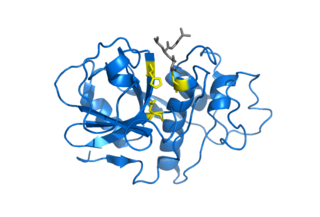
Abamectin (also called avermectin B1) is a widely used insecticide and anthelmintic. Abamectin, is a member of the avermectin family and is a natural fermentation product of soil dwelling actinomycete Streptomyces avermitilis. Abamectin differs from ivermectin, the popular member of the avermectin family, by a double bond between carbons 22 and 25. Fermentation of Streptomyces avermitilis yields eight closely related avermectin homologs, with the B1a and B1b forms comprising the majority of the fermentation. The non-proprietary name, abamectin, refers to a mixture of B1a (~80%) and B1b (~20%). Out of all the avermectins, abamectin is the only one that is used both in agriculture and pharmaceuticals.

Ivermectin is an antiparasitic drug. After its discovery in 1975, its first uses were in veterinary medicine to prevent and treat heartworm and acariasis. Approved for human use in 1987, it is used to treat infestations including head lice, scabies, river blindness (onchocerciasis), strongyloidiasis, trichuriasis, ascariasis and lymphatic filariasis. It works through many mechanisms to kill the targeted parasites, and can be taken by mouth, or applied to the skin for external infestations. It belongs to the avermectin family of medications.

Haemonchus contortus, also known as the barber's pole worm, is a very common parasite and one of the most pathogenic nematodes of ruminants. Adult worms attach to abomasal mucosa and feed on the blood. This parasite is responsible for anemia, oedema, and death of infected sheep and goats, mainly during summer in warm, humid climates.

Benzimidazole is a heterocyclic aromatic organic compound. This bicyclic compound may be viewed as fused rings of the aromatic compounds benzene and imidazole. It is a white solid that appears in form of tabular crystals.

Tribendimidine is a broad-spectrum anthelmintic agent developed in China, at the National Institute of Parasitic Diseases in Shanghai. It is a derivative of amidantel.

Tiabendazole, also known as thiabendazole or TBZ and the trade names Mintezol, Tresaderm, and Arbotect, is a preservative, an antifungal agent, and an antiparasitic agent.

Niclosamide, sold under the brand name Niclocide among others, is an anthelmintic medication used to treat tapeworm infestations, including diphyllobothriasis, hymenolepiasis, and taeniasis. It is not effective against other worms such as flukes or roundworms. It is taken by mouth.

Cysteine proteases, also known as thiol proteases, are hydrolase enzymes that degrade proteins. These proteases share a common catalytic mechanism that involves a nucleophilic cysteine thiol in a catalytic triad or dyad.

Genistein (C15H10O5) is a naturally occurring compound that structurally belongs to a class of compounds known as isoflavones. It is described as an angiogenesis inhibitor and a phytoestrogen.

4-Hexylresorcinol is an organic compound with local anaesthetic, antiseptic, and anthelmintic properties.

Levamisole, sold under the brand name Ergamisol among others, is a medication used to treat parasitic worm infections, specifically ascariasis and hookworm infections. It is taken by mouth.

The avermectins are a group of 16-membered macrocyclic lactone derivatives with potent anthelmintic and insecticidal properties. These naturally occurring compounds are generated as fermentation products by Streptomyces avermitilis, a soil actinomycete. Eight different avermectins were isolated in four pairs of homologue compounds, with a major (a-component) and minor (b-component) component usually in ratios of 80:20 to 90:10. Avermectin B1, a mixture of B1a and B1b, is the drug and pesticide abamectin. Other anthelmintics derived from the avermectins include ivermectin, selamectin, doramectin, eprinomectin.

Ficain also known as ficin, debricin, or higueroxyl delabarre is a proteolytic enzyme extracted from the latex sap from the stems, leaves, and unripe fruit of the American wild fig tree Ficus insipida.

Amoscanate (INN), also known as nithiocyamine, is an experimental anthelmintic agent of the aryl isothiocyanate class which was found to be highly effective in animals against the four major species of schistosomes which infect humans, and is also highly active against hookworm infection. However, significant liver toxicity was seen in lab animals at higher doses. The ether analogue of amoscanate, nitroscanate, is used in veterinary medicine as an anthelmintic.

Oxantel is an anthelmintic. It has typically been used in human and animal medicine as a treatment for intestinal worms. It has also been shown to inhibit fumarate reductase in some pathogenic bacteria.

Ciclobendazole is an anthelmintic, that is a pharmaceutical drug against parasitic worms. It underwent a clinical trial in the 1970s, where it was found to be as effective as mebendazole in the treatment of hookworm infection and ascariasis, but significantly less effective in the treatment of trichuriasis.

Anthelmintics or antihelminthics are a group of antiparasitic drugs that expel parasitic worms (helminths) and other internal parasites from the body by either stunning or killing them and without causing significant damage to the host. They may also be called vermifuges or vermicides. Anthelmintics are used to treat people who are infected by helminths, a condition called helminthiasis. These drugs are also used to treat infected animals, particularly small ruminants such as goats and sheep.

Streptomyces avermitilis is a species of bacteria in the genus Streptomyces. This bacterium was discovered by Satoshi Ōmura in Shizuoka Prefecture, Japan.

Cooperia is a genus of nematode from the Cooperiidae family that is one of the most common intestinal parasitic nematodes in cattle in temperate regions. Infections with Cooperia may result in mild clinical symptoms, but can lead to weight loss and damage of the small intestine, especially when co-infections with other nematodes such as Ostertagia ostertagi occur. Infections are usually treated with broad-spectrum anthelmintics such as benzimidazole, but resistance to these drugs has developed in the last decades and is now very common. Cooperia has a direct life cycle. Infective larvae are ingested by the host. The larvae grow to adults, which reproduce in the small intestines. Eggs are shed onto the pasture with the faeces, which leads to new infections. Co-infections with other gastro-intestinal nematodes such as O. ostertagi and Haemonchus contortus are common.

Monepantel is an anthelmintic approved for use in sheep and cattle to control gastrointestinal nematodes. It belongs to a new class of anthelmintics called aminoacetonitrile derivatives (AAD). It is marketed by Elanco as Zolvix as a single active, or Zolvix Plus in combination with the macrocyclic lactone abamectin.




















